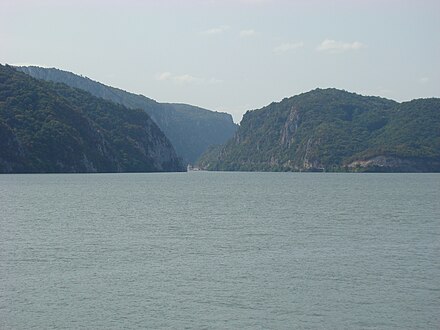Iron Gates Natural Park - natural park in southwestern Romania
Iron Gates Natural Park is in the Banat region of Romania.
Understand
It includes the Romanian part of the Iron Gate of the Danube River.
History
Landscape
Flora and fauna
Thirty-four species of mammals are found in the park, from big carnivores like the brown bear or the lynx to wild cats or red deer. Iron Gates Nature Park is also the home of two rare reptile species, Hermann’s tortoise and the long-nosed viper, both protected and endangered.
Climate
Get in
Fees and permits
Get around
See

- Small Kazan Gorge (Cazanele Mici), 44.640262°, 22.299328°.
- Great Kazan Gorge (Cazanele Mare), 44.603057°, 22.265124°. The most famous and the most narrow part of the Iron Gates gorge. The river here narrows to 150 m and reaches a depth of up to 53 m.
- Rock sculpture of Decebalus (Chipul lui Decebal), 44.640556°, 22.291389°. The tallest rock sculpture in Europe, a 40-m high carving in rock of the face of Decebalus, the last king of Dacia.
- {{see | name=Ponicova Cave | alt=Peștera Ponicova | url= | email= | address= | lat=44.595342 | long=22.261219 | directions= | phone= | tollfree= | fax= | hours= | price= | wikidata=Q12737966 | content=The biggest cave in the Danube Canyon, totalling {{{m|1660}}. Accessible both from the land and from the Danube, by boat. }}
- Tricule Fortress (Cetatea Tricule), 44.480078°, 22.143117°. Ruin of a 15th-century fortress.
Do
- Eibenthal. The biggest Czech community in Romania lives in this small village (~300 inhabitants). A small local restaurant and brewery are available. The reconstructed village access road, with its nickname Transeibenthal referring to Transfăgărășan, is popular among motorcyclists.